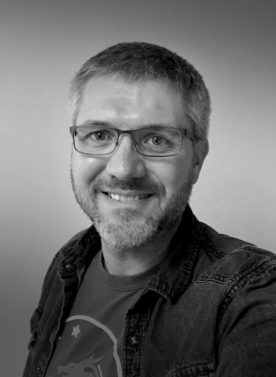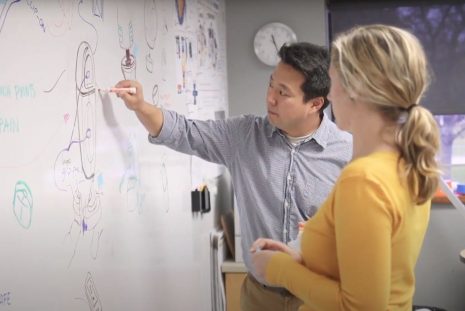One-on-One with Jeremy Odegard

Jeremy Odegard started his career with Phillips-Medisize in 2001 and since then, has played an integral part in leading the Human-Centered Design team that helps design and manufacture life-saving products for our Medical and Pharma Solutions (MPS) Division. Learn more about Jeremy and how his team’s methodology supports our customers and end users in his one-on-one interview below.
Q: Jeremy, tell us a bit about yourself and your background.
Jeremy Odegard: I grew up on a small farm in Western Wisconsin. We raised beef cattle and horses, but my parents also held professional careers outside the home. My Dad was a machinist and my Mom was a journalist for the local newspaper. My parents taught me the value of hard work, creative problem-solving, relationship development, community service, and storytelling. They inspired my sense of curiosity and encouraged me to explore a wide variety of interests. I learned to love drawing, history, woodworking, welding, writing, repairing broken machinery, caring for animals, and photography. As a high school student, I was torn between the pursuit of mechanical engineering and graphic design. I discovered the Industrial Design program at the University of Wisconsin-Stout and realized it offered the balance between art and science that I had been craving.
As a design student at UW-Stout, I was able to dive deeply into diverse range of subjects. I studied art history, color theory, and design methodology. I honed my perspective drawing, sculpture, and digital design skills. I was exposed to practical manufacturing principles such as material science, injection molding, and economics. I also learned valuable lessons about human behavior and research methods through psychology, statistical analysis, and anthropology coursework. Academic education was further enhanced through practical corporate-sponsored design projects with Black & Decker and Puma, where professional designers presented design challenges and provided constructive critique as students worked through the concept development process. I was fortunate to intern with Rollerblade and Toro prior to graduation as well. After I had earned an Industrial Design degree, I joined Logic Product Development (formerly Polivka Logan Design), a consulting firm in Minneapolis that served a broad spectrum of clients and covered a diverse range of market categories. I quickly gained an appreciation for business, respect for my peers, sincere gratitude for patient mentors, and a desire to learn more about all aspects of product development.
Q: How did you end up where you are today at Phillips-Medisize?
JO: A friend mentioned that his company was located just 30 minutes East of the Twin Cities in Hudson, Wisconsin and they needed a new Industrial Designer to join the product development team. I applied, interviewed, and joined Phillips-Medisize (formerly Phillips Plastics Corporation) in 2001.
Since then, our focus and my role have evolved as we recognized the need to transform our team’s range of capability in order to fully address the expectations of our medical and pharmaceutical customers. We requested and received approval from our executive leaders to preserve the core of Industrial Design while expanding more intentionally into the disciplines of Design Research, User Experience Design, and Human Factors Engineering. That led us to begin using the term “Human-Centered Design” in 2010 to more accurately describe our cross-functional group.
Q: What exactly is human-centered design?
JO: Human-Centered Design is a mindset that prioritizes the needs and desires of end-users. Although it’s a label that has been applied to our particular team, the true definition of the term is more broad. Human-Centered Design is really a way of being that should be adopted by everyone who serves others through their work. In order to be fully realized, Human-Centered Design needs to become a cultural norm within an organization.
Q: Have you seen any connections between Human-Centered Design and MBM?
JO: A Human-Centered Design approach to product development is harmonious with MBM principles. We value diversity of thought and respectful challenge. We serve others through our efforts, striving to achieve solutions that will make a positive impact in their lives. The concepts of Mutual Benefit, Principled Entrepreneurship, Self-Actualization, and Value Contribution, in particular, resonate strongly with practitioners of Human-Centered Design.
Designers are required to navigate through ambiguity, address conflicting priorities, and achieve balanced solutions to complex problems. The concept of Mutual Benefit is applied on a regular basis through the design process because we strive to consider every stakeholder’s needs, apply a robust decision-making framework, and design solutions through collaboration.
It is personally and professionally rewarding to solve challenging problems and deliver products that improve the lives of others. The principle of Self-Actualization is reinforced whenever we take the time to pause and remind ourselves why our work matters.

Q: So, what is your team responsible for and how do you use Human-Centered Design?
JO: The Human-Centered Design team engages directly with our customers, end-users, and teammates throughout the product development process to ensure that their perspectives are being considered and needs are being addressed. We begin by conducting research and observing actual users in their natural environment to build a firm foundation of understanding. Once we’ve defined the problems clearly, we begin to brainstorm the way a product could look, feel, and work through an exploratory and iterative process. We build prototypes and share them with representative users to evaluate the effectiveness of our designs and highlight opportunities for further improvement. We work with other development team members to ensure that our concepts are manufacturable and marketable. It takes intentional team effort and collaboration to carry a design from concept into production.
Q: Do you have to be an engineer or in some sort of design role to think this way?
JO: Not necessarily, although it’s very helpful to pursue academic education in a design field. We believe that everyone who influences a design process should adopt a Human-Centered mindset. Special training is required to develop specific skills and perform certain aspects of our work, but everyone is capable of empathy and understanding, which are the most critical elements of Human-Centered Design. Sincere empathy strengthens the foundation of a design process and enables deep understanding of end-user needs.
Q: Why is human-centered design good for the business and good for our customers?
JO: Human-Centered Design principles must be applied to effectively address user needs and enhance the customer experience. It emphasizes understanding and focuses attention on key stakeholder needs during the earliest stages of development. At the Phillips-Medisize Global Innovation and Development Centers, our focus is creating new medical products. Developing a medical device requires sensitivity to the delicate balance between usefulness, usability, desirability, and manufacturability. Every product must be useful (meet a need) and usable (simple to understand) in order to gain regulatory approval. Desirability (user appeal) and manufacturability (production efficiency) must also be woven into a medical device’s design to satisfy business objectives. If we do our jobs well, we will be more likely to exceed customer expectations and generate repeat business.
Applying this methodology can help teams demonstrate their competitive advantage and create an improved user experience. An integrated product development process that truly applies Human-Centered Design principles will create solutions that improve safety and the likelihood of market success.
Q: What is the most rewarding part about the work you do?
JO: Designers enjoy solving problems, especially when the solutions have the potential to improve someone else’s life in a meaningful way. Speaking from personal experience, I’ve seen patients who are suffering from a severe medical condition become emotional when they interact with a prototype that we’ve developed and imagine how their life will be enhanced when the real product becomes available. I’ve seen surgeons simulate a procedure with one of our designs and clap their hands in celebration when they’ve completed a task and realized how their workflow could be improved. I’ve seen products that our company has produced being used by my own family members to deliver a life-changing result. Our work is challenging but it’s encouraging to know that the hours and effort we invest will ultimately improve someone’s quality of life.